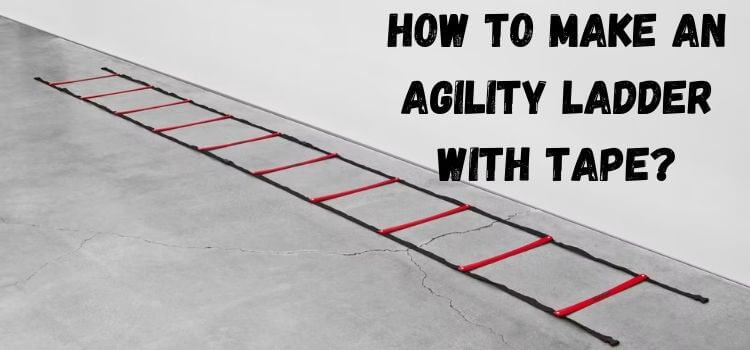As an Amazon Associate, I earn from qualifying purchases
Agility training is essential for everyone looking to enhance their physical performance, including athletes and fitness enthusiasts. An agility ladder is one of the most versatile and cost-effective tools for agility training. This article explores how to make an agility ladder with Tape, providing an affordable and accessible option to elevate your workouts.

Introduction to Agility Ladders
Agility ladders are simple yet effective tools for agility training. They consist of steps or rungs arranged on the ground to enable users to practice different footwork techniques.
In addition to being beneficial for general health and rehabilitation, agility ladder training is employed extensively in sports, including football, basketball, and soccer.
Benefits of Agility Ladder Training
The benefits of agility ladder training are numerous:
- It helps improve speed and agility by challenging your footwork and coordination.
- It enhances balance and proprioception, leading to better overall athleticism.
- Agility ladder drills are a fantastic cardiovascular exercise that enhances heart health and endurance.
Materials Needed for Making an Agility Ladder with Tape
To make an agility ladder with Tape, you’ll need minimal materials:
Duct or masking Tape: Choose a durable tape that can easily stick to the ground.
Scissors: Trim the Tape to the appropriate length.
Measuring tape or ruler: To ensure accurate spacing between ladder rungs.
Open space: Find a flat surface with enough room for the ladder.
These materials are readily available and affordable, making agility ladder training accessible to everyone.
Step-by-Step Guide to Making an Agility Ladder with Tape
Marking the Tape: Begin by cutting several strips of Tape to the desired length, typically around 15-20 inches. These strips will serve as the rungs of your ladder.
Securing the Tape on the Ground: Lay out a long strip of tape parallel to each other, with equal spacing between them. Make sure the Tape is pulled down firmly to keep it from moving while in use.
Spacing and Measurements: Use a measuring tape or ruler to maintain consistent spacing between each rung of the ladder. The spacing can vary depending on your fitness level and the specific drills you intend to perform.
Reinforcing the Ladder: To bolster the ladder and prevent it from moving, add additional strips of tape perpendicular to the rungs. This will provide stability and durability, especially during high-intensity workouts.
Tips for Effective Use of the Agility Ladder
Start slowly and increase your pace gradually. Before trying to accelerate, concentrate on perfecting your footing.
Pay attention to form and technique: to maximum agility and coordination, maintain a low stance with your knees bent and your arms pumping.
Incorporate agility ladder drills: Explore various drills, such as lateral quick steps, high knees, and in-and-out shuffles, to target different muscle groups and movement patterns.
Exercises and Drills for Agility Ladder Training
Lateral Quick Steps: Step laterally in and out of each ladder rung as quickly as possible, focusing on quick footwork and agility.
High Knees: Drive your knees towards your chest as you move through the ladder, maintaining a quick pace and rhythm.
In and Out Shuffle: Shuffle laterally in and out of each ladder rung, keeping your feet light and quick.
Ickey Shuffle: Move laterally across the ladder, alternating your feet in front and behind each rung in a zigzag pattern.
Crossover Steps: Test your agility and coordination by crossing one foot over the other on alternating sides as you move up the ladder.
Safety Precautions
Before starting any agility ladder training, it’s essential to consider safety:
Checking the surface: Ensure the ground is flat and free of any debris or obstacles that could cause tripping or injury.
Wearing appropriate footwear: Choose athletic shoes with plenty of support and traction to reduce the chance of slipping or falling.
Maintaining proper hydration: Drink plenty of water before, during, and after your workout to stay hydrated and prevent fatigue.
Progression and Variation
As you become more proficient with agility ladder training, don’t be afraid to increase the complexity and intensity of your workouts. Ankle weights or a weighted vest are good ways to increase resistance.
You can also use obstacles like cones or hurdles to add further challenges.
Importance of Consistency
Like any other exercise type, consistency is essential in agility ladder training. Aim to incorporate ladder drills into your routine at least 2-3 times per week, gradually increasing the duration and intensity as you progress.
Common Mistakes to Avoid
Overstriding: Avoid taking giant steps between ladder rungs, which can compromise your balance and agility.
Lack of focus: Maintain mental focus during your exercises, paying close attention to form and technique to get the most out of every practice.
Neglecting warm-up and cooldown: To prepare your muscles and joints for exercise, always begin with a dynamic warm-up. To minimize damage and expedite healing, always end with a cooldown.
Incorporating Agility Ladder Training into Your Routine
Agility ladder training can be easily integrated into your existing workout routine. Ladder drills can be used as stand-alone exercises or in circuits or interval training sessions.
To keep yourself motivated and accountable, set specific goals for your agility training, such as increasing your foot speed or agility, and monitor your progress over time.
Testimonials and Success Stories
Many athletes and fitness enthusiasts have experienced significant improvements in their performance and athleticism through regular agility ladder training.
Whether it’s a soccer player improving their agility on the field or a fitness enthusiast enhancing their cardiovascular fitness, the benefits of agility ladder training are undeniable.
FAQs About Making and Using an Agility Ladder with Tape
Duct tape or masking Tape are both suitable options for making an agility ladder, as they are durable and adhere well to the ground.
While Tape is the most common option for making an agility ladder, you can also use chalk or spray paint to mark the ladder on the ground.
Add agility ladder training to your regimen twice or thrice weekly for best effects.
It is possible to adapt agility ladder training to fit people of different ages and fitness levels, including kids.
Beginner-friendly agility ladder drills include simple exercises such as lateral quick steps and high knees, focusing on mastering the basic footwork before progressing to more advanced drills.
Conclusion
In conclusion, agility ladder training is highly effective and accessible for improving speed, agility, and overall athleticism. Following the instructions in this article, you may quickly make your tape agility ladder and begin using this adaptable training aid. Remember to start slowly, focus on proper form and technique, and stay consistent with your workouts to see significant improvements in your physical performance.
Read Our More Articles
- Do Agility Ladders Work? An Expert’s Guide
- How Long is an Agility Ladder? A Comprehensive Overview
- How to Untangle Agility Ladder: Quick Tips for Easy Setup
As an Amazon Associate, I earn from qualifying purchases


